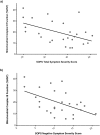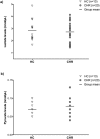Mitochondrial function in individuals at clinical high risk for psychosis
- PMID: 29670128
- PMCID: PMC5906614
- DOI: 10.1038/s41598-018-24355-6
Mitochondrial function in individuals at clinical high risk for psychosis
Abstract
Alterations in mitochondrial function have been implicated in the etiology of schizophrenia. Most studies have investigated alterations in mitochondrial function in patients in which the disorder is already established; however, whether mitochondrial dysfunction predates the onset of psychosis remains unknown. We measured peripheral mitochondrial complex (I-V) function and lactate/pyruvate levels in 27 antipsychotic-naïve individuals at clinical high risk for psychosis (CHR) and 16 healthy controls. We also explored the association between mitochondrial function and brain microglial activation and glutathione levels using a translocator protein 18 kDa [18F]FEPPA PET scan and 1H-MRS scan, respectively. There were no significant differences in mitochondrial complex function and lactate/pyruvate levels between CHR and healthy controls. In the CHR group, mitochondrial complex III function (r = -0.51, p = 0.008) and lactate levels (r = 0.61, p = 0.004) were associated with prodromal negative symptoms. As previously reported, there were no significant differences in microglial activation and glutathione levels between groups, however, mitochondrial complex IV function was inversely related to microglial activation in the hippocampus in CHR (r = -0.42, p = 0.04), but not in healthy controls. In conclusion, alterations in mitochondrial function are not yet evident in CHR, but may relate to the severity of prodromal symptoms, particularly negative symptoms.
Conflict of interest statement
The authors declare no competing interests.
Figures





References
Publication types
MeSH terms
Substances
Grants and funding
LinkOut - more resources
Full Text Sources
Other Literature Sources
Medical
Research Materials

